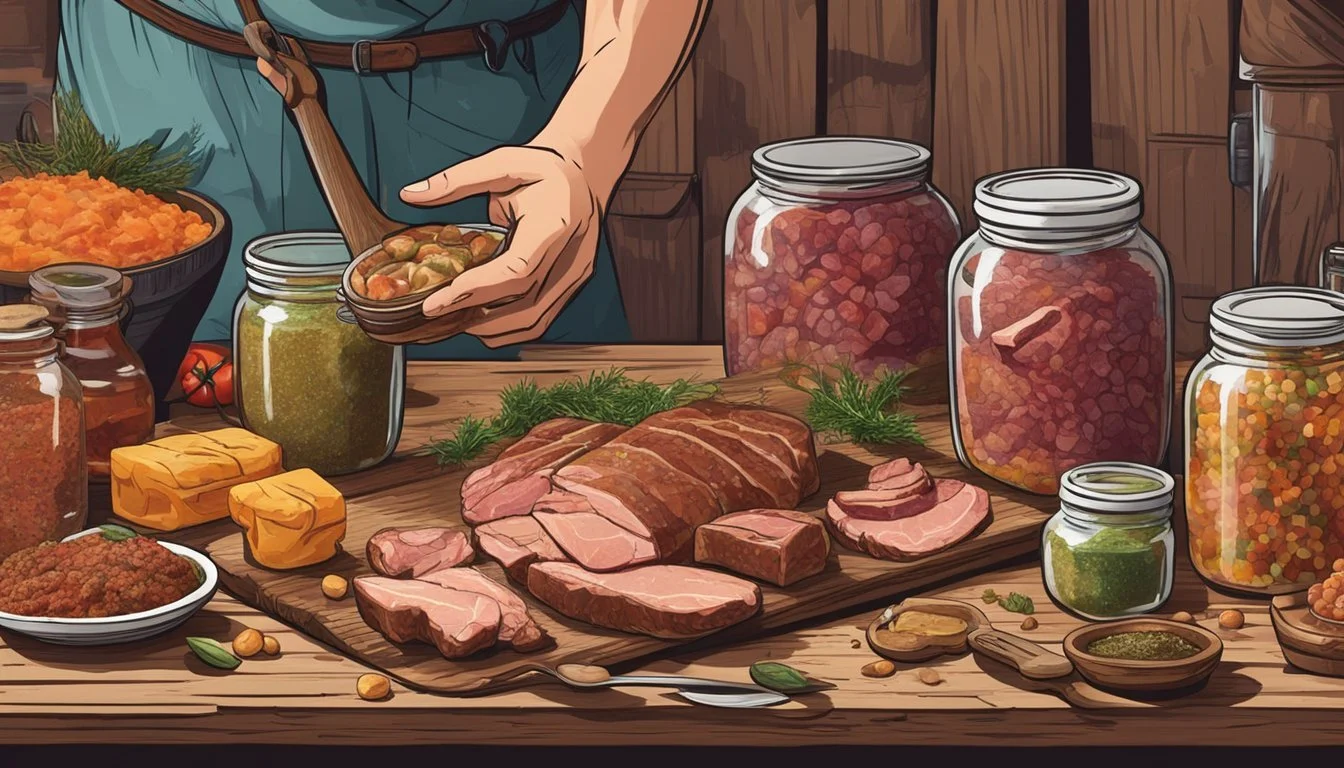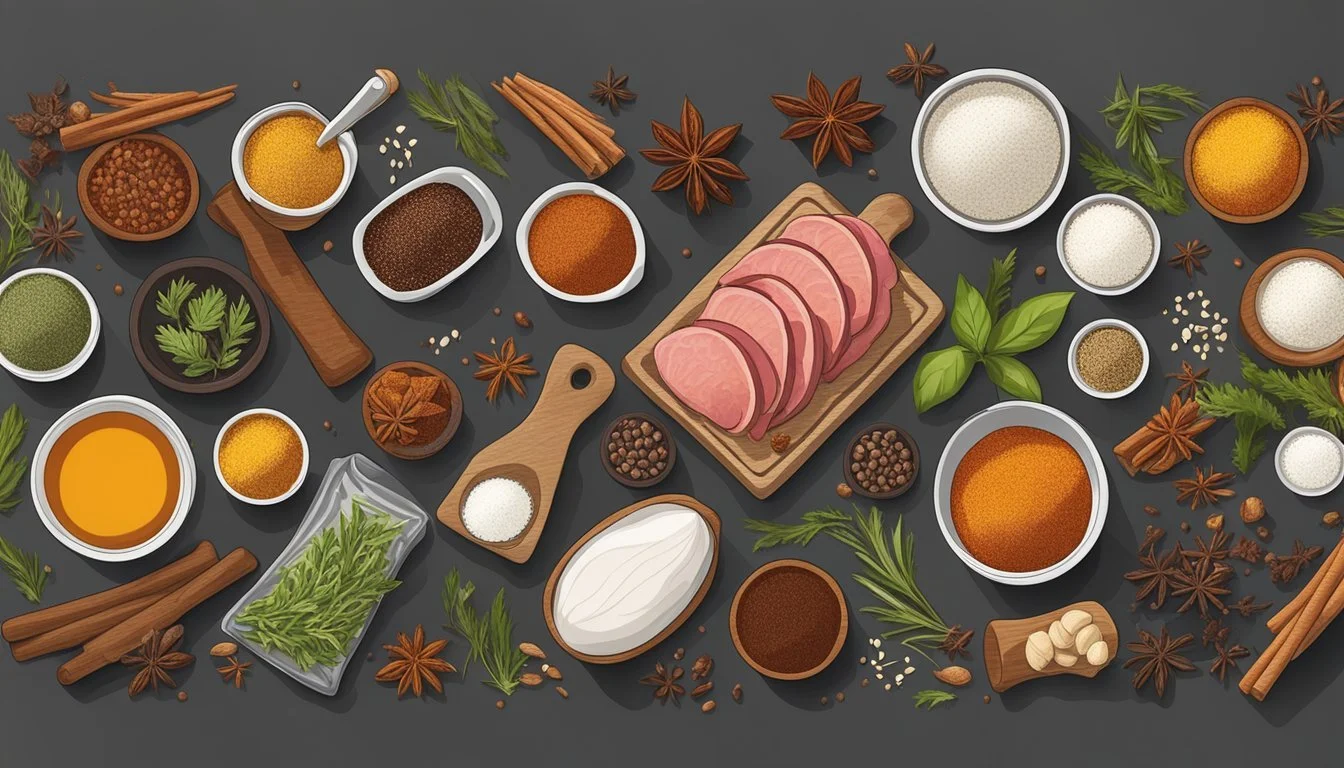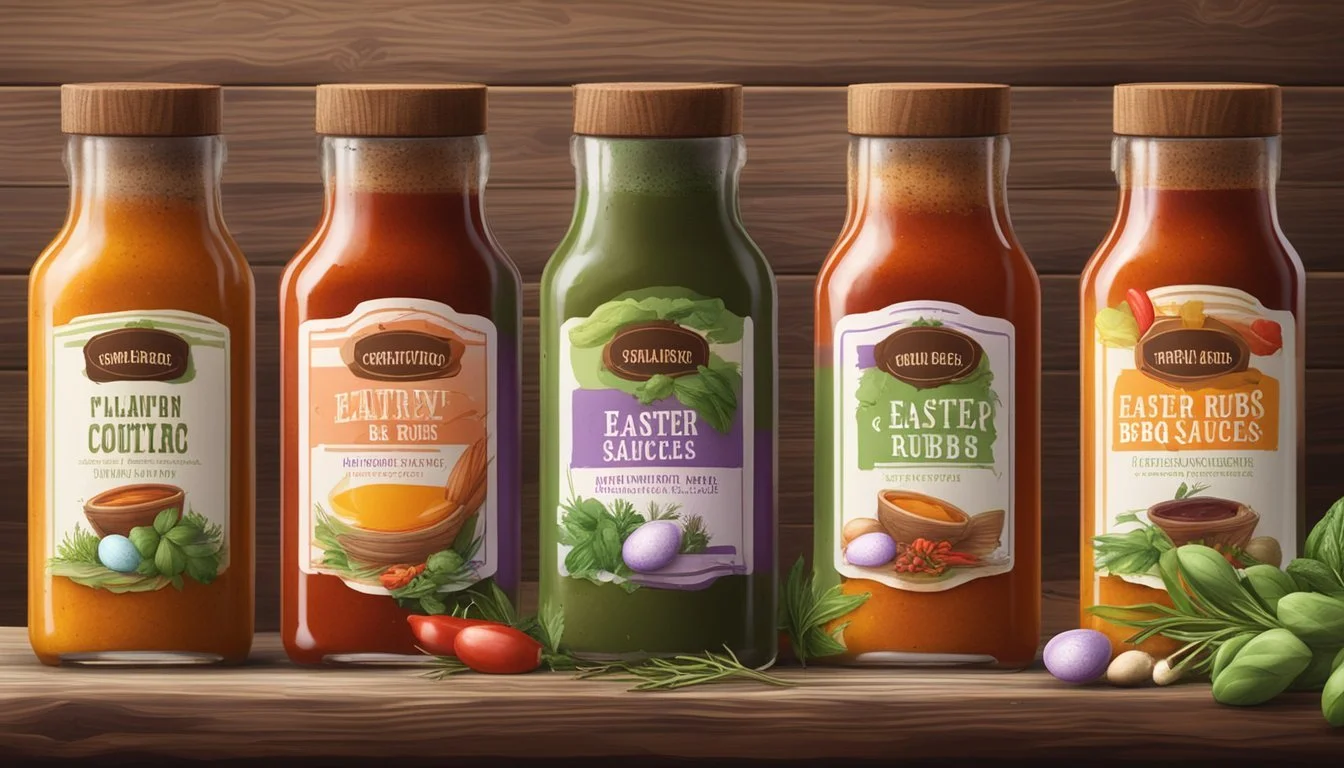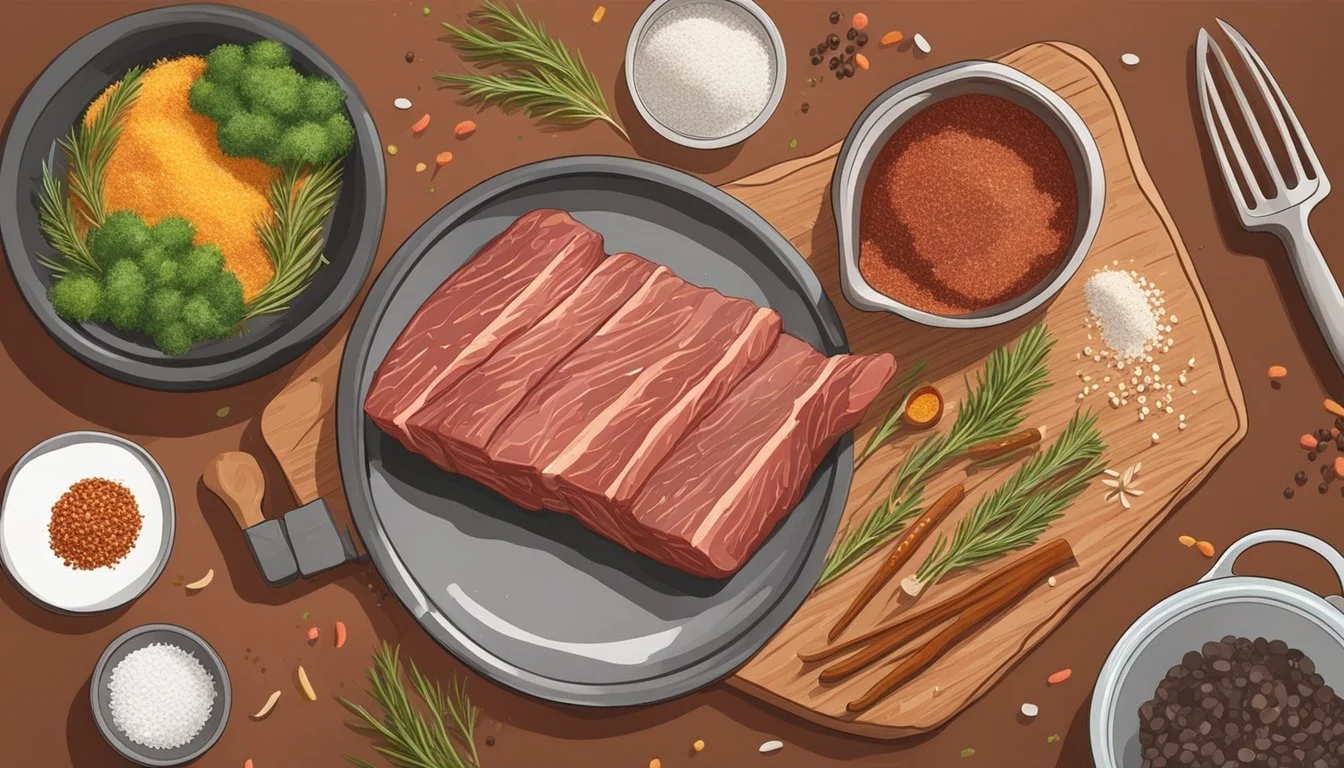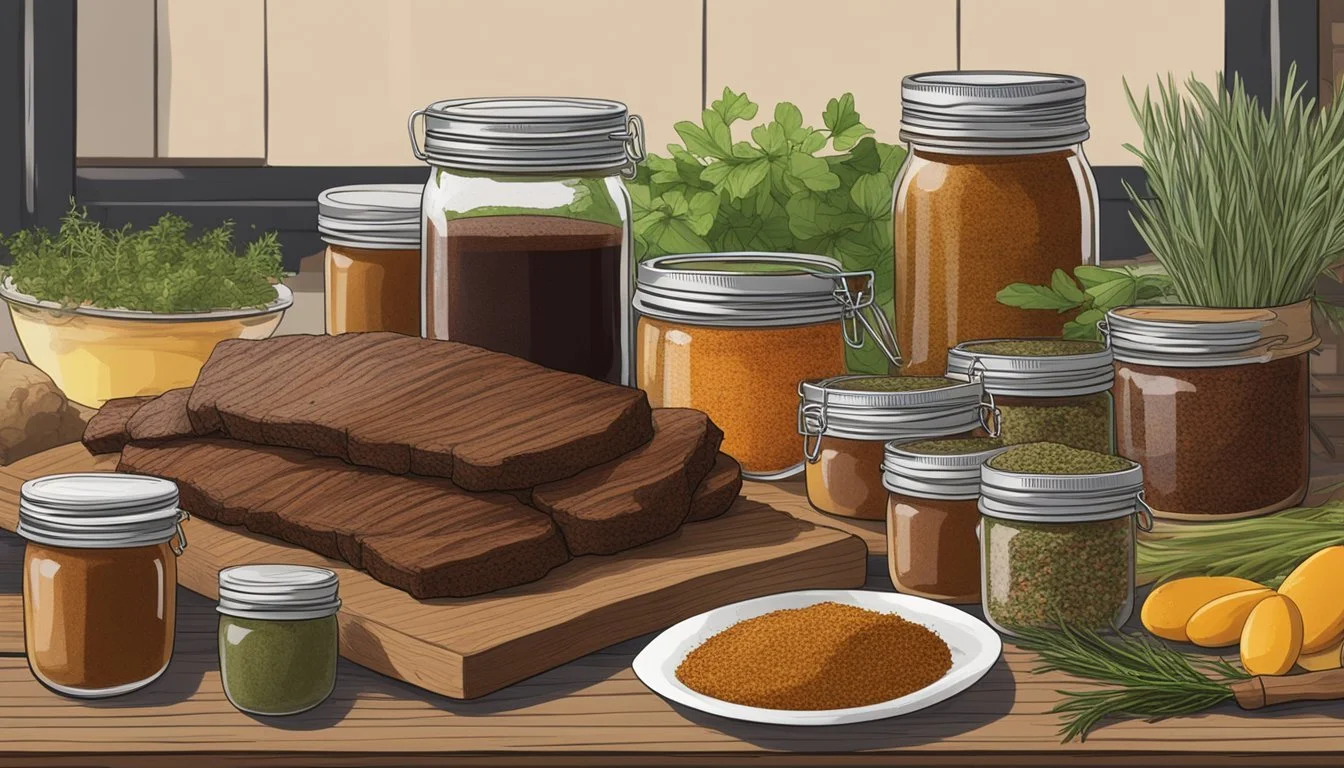Country BBQ Rubs and Marinades for Easter Meats
Elevate Your Holiday Feast
Easter celebrations often bring families together around tables laden with an array of traditional and delicious meats. To elevate these central dishes, country BBQ rubs and marinades play a crucial role in enhancing the flavors of Easter feasts. Whether it's the succulence of a spiraled ham, the tender juiciness of a smoked lamb shoulder, or a classic brisket, the right combination of spices and herbs can transform these meats into unforgettable culinary experiences.
Crafting the perfect rub or marinade involves a balance of savory, sweet, and spicy components that complement the specific type of meat being prepared. For instance, a robust blend of kosher salt, black pepper, garlic, and onion powders can impart a rich, smoky crust on a brisket, while a marinade for lamb might include ingredients like rosemary and thyme to highlight its naturally rich flavors. Home cooks and professional chefs alike know that the secret to mouthwatering Easter meats lies not only in the cooking technique but also in the art of seasoning.
History of Easter BBQ Traditions
Easter is a time of celebration, where food plays a central role in the festivities. The tradition of barbecuing during Easter has roots in various cultures, each with its distinctive cooking styles and flavors. The use of grill and barbecue (What wine goes well with barbecue?) adds a distinct smoky taste to Easter meats, showcasing the versatility of food preparation methods during this springtime holiday.
Easter BBQ in the United States tends to reflect regional barbecue traditions. In the South, Easter may involve slow-cooking meats over wood or charcoal, infusing them with a deep, smoky flavor. The result is tender, often fall-off-the-bone quality meats that are savored during Easter gatherings.
Marinades and Rubs: Key to infusing flavor into barbecued Easter meats, marinades and rubs vary widely. They can range from sweet and sticky, often found in traditions like that of Kansas City, to tangy and vinegar-based, characteristic of North Carolina. These flavorings contribute significantly to the barbecue experience, adding a layer of complexity to the food.
Regional BBQ Styles Description Kansas City Known for sweet, molasses-based sauces. North Carolina Features tangy vinegar-based sauces. Texas Often prefers dry rubs with a spicy kick.
In today's culinary approach, individuals often experiment with different herbs, spices, and sauces to create their unique Easter BBQ experience, proving that while traditions offer a foundation, modern practices are as diverse as the people celebrating. The key is the loving preparation typically involving a grill, which has remained a constant in delivering flavorful, smoky food that is synonymous with Easter celebrations.
Selecting Meats for Easter
For a memorable Easter feast, it is important to choose the right meats that will pair well with hearty rubs and delicate marinades. Each meat, with its specific texture and flavor profile, requires careful selection to ensure a successful barbecue.
Considering Pork and Ham Options
When it comes to pork, ham reigns supreme for Easter celebrations. Smoked and honey glazed, it serves as a centerpiece that's both traditional and versatile. Additionally, pork ribs (What wine goes well with pork ribs?) offer a rich canvas for a variety of barbecue rubs, allowing for a mix of smoky and sweet flavors that are perfect for an Easter gathering.
Best Cuts of Beef to Grill
For beef enthusiasts, a ribeye or filet provides an excellent grilling experience. These cuts are known for their tenderness and are best enjoyed with simple seasonings to let their natural flavors shine. Using a specialized beef rib rub can enhance the meat's exterior crust without overpowering its natural taste.
Poultry Selections: Chicken and Turkey
Poultry, specifically chicken and turkey, are popular choices that can be easily scaled to accommodate gatherings of any size. Chicken legs and thighs, with their juicy meat, are well-suited for grilling and absorb the flavors of marinades and rubs effectively. Turkey, often reserved for Thanksgiving, can also be a succulent option for Easter when prepared with a complementary barbecue marinade.
Exploring Lamb and Other Meats
Lamb, often overshadowed by other meats, provides a uniquely rich and savory option. Ideal cuts for grilling include lamb rack or chops, which can be cooked to tender perfection. Not to be limited to just typical choices, there's also room for creativity with meats like fish or even mixed vegetables for those seeking variety or catering to different dietary preferences.
Essential BBQ Rubs and Marinades
Easter meats acquire a remarkable depth of flavor through the application of carefully crafted BBQ rubs and marinades. These concoctions, when used appropriately, transform the simplest ingredients into a festive feast.
Preparing Dry Rubs for Enhanced Flavors
Dry rubs are a blend of ground spices and seasonings that impart a bold, concentrated flavor to meats. For an authentic BBQ experience, a homemade BBQ rub recipe can include a base of brown sugar to develop a caramelized crust, kosher salt to draw out natural flavors, and black pepper for a hit of spice. Essential spices include paprika for smokiness, garlic powder for a sharp kick, and chili powder for an added warmth.
BBQ Spice Rub Ingredients:
1/4 cup brown sugar
2 tbsp kosher salt
1 tbsp black pepper
1 tbsp paprika
1 tsp garlic powder
1 tsp chili powder
Thoroughly mix these ingredients and store them in an airtight container. For optimal taste, liberally season the meat and consider using a dry brine method, allowing it to sit for a few hours or overnight to penetrate the flavors deeply.
Crafting Savory Marinades
Marinades combine liquids such as oil with spices and herbs to create a bath in which meats can soak to absorb additional flavors. Essential ingredients for a versatile marinade include salt for flavor enhancement, garlic for its pungent taste, and herbs like rosemary and thyme for an aromatic touch. For added moisture and infusion of flavors, acid ingredients like vinegar or citrus juices can be incorporated.
Basic BBQ Marinade Recipe:
1/2 cup olive oil
1/4 cup soy sauce or Korean BBQ sauce
2 cloves garlic, minced
1 tbsp rosemary, chopped
1 tbsp thyme, chopped
Salt to taste
Whisk the ingredients together and soak the chosen meat for several hours, depending on its toughness; a general guideline is 15 minutes to 2 hours for tender meats and up to 24 hours for tougher cuts. When ready to cook, remove the meat and discard the remaining marinade. This process ensures a tender, well-seasoned Easter meal.
Spices and Seasonings for Every Palate
Preparing meat with the right blend of spices and seasonings elevates the flavor and can cater to a variety of taste preferences. For a harmonious Easter feast, here are key ingredients that can form the foundation of any country BBQ rub or marinade:
Salt: Kosher salt is a preferred choice, as its flaky texture adheres well to meat surfaces.
Sugars: To add a sweet dimension that caramelizes under heat, brown sugar is commonly used.
Peppers: Black pepper adds warmth, while cayenne pepper brings a spicy kick. Select according to your heat preference.
For more nuanced flavors, the following spices and seasonings are essential:
Spice/Seasoning Flavor Profile Paprika Sweetness with mild heat; smoked paprika adds depth Onion Powder Subtle sharpness, a hint of sweetness Garlic Powder Pungent and earthy Mustard Powder Tangy and slightly spicy
An array of other spices like cumin, chili powder, or ground mustard seeds can be artfully combined to create a rich tapestry of taste. Herbs, such as thyme or oregano, provide an aromatic touch complementing the meats' natural flavors.
Heat Elements: A dash of cayenne pepper or crushed red pepper flakes can be added for those who favor a fiery palate.
Aromatic Spices: Cloves and cumin add a warm and aromatic character, perfect for festive occasions.
These spices and seasonings can be mixed and matched to achieve the desired flavor profile, from sweet and savory to bold and spicy. Each contributes its unique quality, ensuring there's a perfect seasoning blend for every palate at the Easter table.
Specialty Easter BBQ Sauces
Easter celebrations often call for special touches on traditional recipes, including BBQ sauces that add a unique twist to smoked and grilled meats. Chefs and home cooks alike might consider the following sauces to elevate their Easter feast:
Tangy Mustard Sauce: A staple in Southern BBQ culture, this sauce mixes the sharpness of mustard with a hint of sweetness. It pairs beautifully with lamb or ham.
Ingredients Description Yellow Mustard Base for tangy flavor Honey/Brown Sugar Adds sweetness Apple Cider Vinegar Provides a tangy sharpness Spices To taste
Sweet and Spicy Sauce: This sauce balances sweetness with a kick, complementing the smokiness of BBQ meats. Use it on chicken wings or ribs for depth of flavor.
Sweet elements: Brown sugar or honey
Spicy notes: Cayenne or chili flakes
Garlic Herb Sauce: For those who prefer earthy flavors, a garlic herb sauce with a base of olive oil can highlight the natural flavors of meats like brisket or roast beef.
Key ingredients: Garlic, rosemary, thyme
Recommended meat: Beef or pork
Korean BBQ Sauce: With its fusion of soy, ginger, and sweeteners, Korean BBQ sauce lends a distinctive profile that goes well with beef short ribs (What wine goes well with beef short ribs?) and can be a gourmet addition to a traditional Easter BBQ.
Flavor profile: Sweet, garlicky, and a bit of heat
Ideal for: Beef short ribs
Chefs should consider these sauces as frameworks and feel encouraged to adjust the sweetness, tanginess, or spice levels to achieve the desired harmony with their chosen meats. Using quality ingredients and respecting the balance of flavors are key to creating memorable Easter BBQ sauces.
Cooking Techniques and Tips
When preparing Easter meats, selecting the right cooking technique and applying tips to enhance flavor and texture is essential. The following subsections offer guidance on grilling and smoking methods, achieving the ideal crust and moisture balance, and utilizing a slow cooker for consistent BBQ results regardless of the weather.
Grilling and Smoking Methods
Grilling and smoking are two popular methods for cooking Easter meats, with each technique imparting a unique flavor and texture. For grilling, a consistent medium-high heat allows for even cooking. Meats should be flipped only once to prevent toughness. When smoking, maintaining a steady low temperature is critical, usually between 225°F and 250°F, and can be achieved using various types of wood chips or pellets to infuse different flavors.
Key Temperatures:
Grilling: Medium-high (375°F to 450°F)
Smoking: Low (225°F to 250°F)
Achieving the Perfect Crust and Moisture
The perfect crust on meat is the sign of a well-executed BBQ, providing a caramelized, flavorful exterior. To achieve this, use a dry rub of choice, with a base of coarse salt to help penetrate the meat. The searing of meat on a hot surface creates this highly desired crust. Ensuring moisture is retained is equally important; marinating meats or using a mop sauce during cooking helps preserve the natural juices.
Key Points:
Use a dry rub for seasoned crust
Sear at high temperature for the crust
Marinate or mop to retain moisture
Slow Cooker BBQ for All Weather
A slow cooker offers a foolproof BBQ option that is weather-independent. This method is excellent for tenderizing tougher cuts of meat over several hours. Begin by applying a generous amount of your favorite dry rub to the meat, then place it in the slow cooker with a flavorful liquid like stock or BBQ sauce. The slow, consistent heat allows flavors to penetrate deeply, resulting in succulent, fall-apart meat.
Steps:
Season meat with dry rub
Place in slow cooker with liquid
Cook on low for 6-8 hours or high for 3-4 hours
Complementary Side Dishes
Pairing the right side dishes with barbecue meats elevates the meal, providing a balanced plate that tickles every taste bud. Fresh vegetables and hearty potatoes prepared with a mélange of herbs and spices complement the smoky richness of barbecued meats (What wine goes well with barbecued meats?) admirably.
Vegetable Sides and Salads
For vegetable sides, one can never go wrong with a Roasted Parmesan Sweet Potato dish. It strikes an ideal balance between sweetness and savory notes, with parmesan adding a delightful umami kick. Another excellent choice is Green Beans with Candied Pecans, offering a crunch that contrasts beautifully with the tenderness of well-cooked meat. These sides not only bring a variety of flavors but also add a charming splash of color to one's plate.
Roasted Parmesan Sweet Potato
Sweet potatoes: cubed and roasted
Parmesan: generously grated
Herbs: rosemary or thyme for an aromatic touch
Green Beans with Candied Pecans
Green beans: blanched to preserve crispness
Pecans: caramelized in sugar for a sweet crunch
Herbs and spices: mix of selected herbs for seasoning
Potato Dishes and Variations
Potato dishes are quintessential barbecue accompaniments, and a Twice Baked Potato Casserole is a crowd-pleaser, blending fluffy potatoes with rich, melty cheese. It's all about texture and flavor, embodying the ultimate comfort food. For those looking to add a zesty touch to their meal, a Herby Roasted Potato Salad might be the perfect addition, seasoned with a harmonious blend of herbs and spices.
Twice Baked Potato Casserole
Potatoes: twice baked, mashed, and mixed with cheese
Cheese: sharp cheddar for a flavorful depth
Herby Roasted Potato Salad
Potatoes: roasted until golden and crisp
Herbs and spices: parsley, dill, and paprika for a flavorful burst
Vegetarian and Vegan Alternatives
As more individuals embrace plant-based diets, vegetarian and vegan alternatives have become essential at any gathering, including traditional barbecue events like Easter. These alternatives focus on capturing the essence of BBQ flavor through inventive use of spices and marinades on non-meat options such as tofu, tempeh (What wine goes well with tempeh?), and a variety of vegetables.
Tofu and Tempeh BBQ Options
Tofu, a versatile protein derived from soybeans, and tempeh, made from fermented soybeans, adopt flavors remarkably well, making them perfect for barbecue marinades. To ensure these alternatives provide the depth of flavor associated with barbecue, it's essential to press tofu for at least 30 minutes to remove excess water, allowing it to absorb the marinade more effectively. For both tofu and tempeh, a marinade of spices like smoked paprika, garlic powder, and a hint of cayenne pepper combined with BBQ sauce can create a savory, smoky flavor profile.
Marinade example for Tofu/Tempeh:
3 tbsp BBQ sauce
1 tsp smoked paprika
1/2 tsp garlic powder
1/4 tsp cayenne pepper
1 tbsp olive oil
Salt to taste
Marinate the tofu or tempeh for at least one hour before grilling to ensure the flavors penetrate deeply.
Grilled Veggies and Mushroom Steaks
Grilled vegetables (What wine goes well with grilled vegetables?) and portobello mushroom steaks are a must-have for their ability to mimic the meaty texture and offer an array of flavors and nutrients. Veggies such as bell peppers, zucchini, and eggplant, slice them thickly and brush with a marinade of balsamic vinegar, olive oil, and mixed herbs before placing on a well-oiled grill to prevent sticking. Portobello mushrooms can be transformed into "steaks" with a simple marinade and offer a satisfying, umami-rich alternative to meat.
Marinade example for Vegetables/Mushrooms:
2 tbsp balsamic vinegar
3 tbsp olive oil
1 tsp mixed dried herbs
1/2 tsp black pepper
Salt to taste
Brush the marinade on the vegetables and let them sit for 15 minutes. Grill on medium heat until charred and tender.
Food Preservation and Storage
Proper storage is essential to maintaining the freshness and flavors of country BBQ rubs and marinades, especially when preparing for Easter meats. It's important to understand the differences in shelf life between these two, and how to best keep them for quality and safety.
Marinade Shelf Life and Refrigeration
When it comes to marinades, they can be quite perishable due to the inclusion of acidic ingredients and sometimes fresh herbs. A homemade marinade should be used within 3-5 days when stored in the refrigerator. Commercially prepared marinades have a longer shelf life, often up to several months, thanks to preservatives. However, once opened, one should follow the same 3-5 days rule for safety. To ensure a marinade's quality:
Use within 3-5 days if homemade or once opened.
Store in a tightly sealed container in the refrigerator to prevent contamination.
Never reuse a marinade that has been in contact with raw meat without boiling it first to destroy harmful bacteria.
Storing and Reusing BBQ Rubs
BBQ rubs, which are typically dry blends of herbs and spices, have a longer shelf life compared to marinades. They can be stored in a cool, dry place away from light for 1-2 years. To maximize a rub's shelf life:
Seal tightly after each use to prevent moisture and contaminants.
Check for clumping or dampness as signs that the rub may have been compromised.
Consider date labeling the container to keep track of freshness.
By adhering to these storage principles, one can ensure that their BBQ rubs and marinades are always at peak performance for enhancing their Easter meats.
Enhancing Flavors with Condiments and Garnishes
When preparing Easter meats, the right condiments and garnishes not only complement the dish but can elevate its flavors to new heights. Incorporating a balance of spices and herbs, along with assertive flavors like horseradish and mustard, can transform a meal.
Creative Use of Spices and Herbs
A carefully selected array of spices and herbs can add depth and complexity to any dish. For a sweet yet smoky profile, one might consider blending brown sugar with smoked paprika. This creates a pleasant contrast that enhances the natural savoriness of meats. A tangy lift can be achieved by adding a small amount of ground mustard to the mix, providing a subtle warmth that doesn't overpower.
For those who prefer a spicy kick, chili flakes can be incorporated sparingly. Fresh herbs like rosemary and thyme offer a fragrant note that is particularly well-suited for lamb, a traditional Easter choice.
Sweet and Smoky Rub:
2 tbsp Brown Sugar
1 tsp Smoked Paprika
1/4 tsp Ground Mustard
Pinch of Chili Flakes
1 tsp Chopped Fresh Rosemary (optional)
1 tsp Chopped Fresh Thyme (optional)
Horseradish and Mustard Variations
Horseradish provides a potent and piquant flavor ideal for cutting through the richness of Easter meats. Its sharpness enhances flavors without the need for excessive salt. It can be offered as a garnish or incorporated into a marinade or sauce for a more profound impact.
Mustard variations, from the milder Dijon to the robust brown mustard, contribute varied levels of tanginess and spice. Brown mustard, often noted for its hearty flavor, complements the robustness of beef or pork. Dijon mustard, with its smoother profile, is versatile and can be used to emulsify vinaigrettes that are perfect for dressing salads accompanying the meal.
Mustard-Horseradish Sauce:
1/4 cup Prepared Horseradish
1 cup Brown or Dijon Mustard
2 tbsp Apple Cider Vinegar (for Dijon variant)
By mindfully selecting and combining these elements, one can craft a unique and memorable Easter feast that is sure to delight the palate.
BBQ Presentation and Serving Ideas
Mastering the presentation and serving of BBQ dishes enhances the overall dining experience. A visually appealing plate and thoughtful pairings can make your Easter meats memorable.
Plating Techniques for Visual Appeal
For visual appeal, one should prioritize contrast and balance when plating BBQ meats. Arranging slices of meat with a slight overlap showcases the cook on each piece, while garnishes like a sprig of rosemary or a scattering of chopped chives add a pop of color. On Instagram, vibrant images of well-presented BBQ can garner significant attention, with hashtags like #bbqplating drawing food enthusiasts.
Serving Sizes and Dish Pairings
Serving size is crucial for ensuring each guest can try a variety of Easter meats. An ideal portion might include 2-3 slices of meat, allowing room for sides. Pairing meats with complementary dishes not only enhances flavors but also the visual palette of the table. For example:
Smoked brisket: Pair with tangy coleslaw and grilled vegetables.
Spice-rubbed ribs: Complement with sweet cornbread and a cooling cucumber salad.
Considering the recipes as part of a cohesive menu is essential when aiming to create an appealing and delicious BBQ spread.
Tips for a Successful Easter BBQ Cookout
As families gather for Easter feasts, a well-prepared BBQ can elevate the celebration. The key to a memorable cookout lies in meticulous grill preparation and mastery of BBQ techniques.
Season Prep and Grill Maintenance
Before the grilling season officially commences, one must ensure their grill is in optimal condition. Start by inspecting for any wear or damage that may have occurred during the off-season. It's critical to clean the grill grates thoroughly to remove any rust or old residue. After cleaning, the next step is to season the grill:
Clean grates with a brush and soapy water.
Rinse and dry completely.
Apply a light coat of oil that can withstand high temperatures, like canola or vegetable oil, onto the grates.
Turn on the grill to medium heat for approximately 15-20 minutes until the oil burns off and the grates develop a non-stick surface.
Through these steps, the grill not only performs better but also imparts a clean, smoky flavor to the meats.
Advanced BBQ Techniques
Grilling and BBQing are culinary arts that benefit from refined techniques that chefs develop over time. For an Easter cookout, where a variety of meats may be on the menu, it's imperative to tailor the cooking approach to each cut:
Direct grilling is ideal for thinner cuts of meat that cook quickly over high heat. It results in a desirable sear and char.
Indirect grilling is the method of choice for large, tougher cuts needing longer cooking times, like briskets or whole chickens. This technique requires placing the meat away from the immediate heat source and closing the lid to create an oven-like environment.
Marinades and rubs play an essential role in BBQ and should be selected to complement the specific type of meat. A well-crafted rub can consist of a mixture of salt, sugar, and spices that not only seasons the meat but also forms a crusty 'bark' that BBQ enthusiasts adore. For instance, an Easter ham might shine with a sweet and smoky rub that includes ingredients like brown sugar, paprika, and ground mustard. Proper seasoning can deeply influence the final taste of the BBQ, making it crucial to use rubs and marinades that enhance the natural flavors of the meats.
BBQ Safety and Hygiene
When preparing food for an Easter barbecue, safety and hygiene are paramount to ensuring a delicious and safe meal. It is critical to avoid cross-contamination between raw and cooked foods. Meats, especially, should be handled with care. One should always use separate utensils and cutting boards for raw and cooked meats.
Wash hands thoroughly with soap and water before and after handling raw meat.
Clean all surfaces and utensils with hot soapy water or a disinfectant.
Keep meats refrigerated until they are ready to be placed on the grill.
During the cooking process, using a meat thermometer to check that meats have reached safe internal temperatures is essential for safety.
For example, poultry should be cooked to an internal temperature of 165°F (74°C), and beef should reach at least 145°F (63°C).
Cooking Temperatures:
Meat Type Safe Internal Temperature Poultry 165°F (74°C) Beef (Medium) 145°F (63°C) Pork 145°F (63°C) Ground Meats 160°F (71°C)
After cooking, foods should not sit out for extended periods. The danger zone for bacterial growth is between 40°F - 140°F (4.4°C - 60°C). Leftovers should be refrigerated within two hours of cooking.
Lastly, one should never reuse marinades that have been in contact with raw meats unless they are boiled first to eliminate bacteria. By following these guidelines, individuals can enjoy their Easter feast confidently, knowing that food safety has been prioritized.



